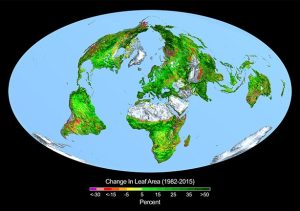Sorry Biden, CO2 Is Not Pollution. It’s The Currency Of Life
by Joseph Fournier
I don’t know about you, but I am tired of being bombarded everyday by the claim that CO2 is a pollutant and that as a polluter I must pay.
I seriously doubt the average person would accept this perspective, if they understood that CO2 is in fact a prerequisite of Life, and that global food production will expand by trillions of dollars in the coming decades as CO2 levels continue to rise.
Even fewer would accept CO2 as a pollutant if they understood that over a century ago, Svante Arrhenius, the Nobel Laureate and Father of the Enhanced Greenhouse Gas Hypothesis (EGGH), predicted that:
“By the influence of the increasing percentage of carbonic acid [i.e. CO2] in the atmosphere, we may hope to enjoy ages with more equable and better climates, especially as regards the colder regions of the earth, ages when the earth will bring forth much more abundant crops than at present, for the benefit of rapidly propagating mankind.”
In other words, the father of the EGGH argued that humanities’ use of hydrocarbons and rising tropospheric CO2 concentrations would benefit Planet Earth.
Oh, the irony!
The examples that I will showcase that demonstrate that Arrhenius’ predictions are coming true are 1) the expanding Plant Kingdom, 2) the acceleration of agricultural productivity, and 3) the climate stabilizing effects of rising CO2.
All these factors are due to what is commonly called the CO2 fertilization effect.
The CO2 fertilization effect in plants is a reference to the fact that both the rate of photosynthesis and H2O use efficiency increases in lockstep with ambient CO2 concentrations.
As a result, the drought resistance of the Plant Kingdom naturally improves as CO2 concentrations increase, and most plants will produce more foliage per mm of precipitation.
This is why commercial greenhouses artificially raise ambient CO2 by 3x to 4x above atmospheric concentrations.
Remote sensing data from satellites have shown that the expansion of the Plant Kingdom from 1982 to 2015 was equivalent to adding over 20 million square kilometers of leaf surface area or twice the size of United States.
Numerous studies have shown that the higher latitude Boreal Forests and semi-arid desert ecosystems along the Horse Latitudes are where the Plant Kingdom has experienced the greatest benefit. The illustration provided here shows that leaf area in the Arctic region has expanded by 25 to 50 percent over this short time span.

This image shows the change in leaf area across the globe from 1982-2015.
Credit: Boston University/R. Myneni
Thus, it should not be surprising that global agricultural productivity has likewise been steadily rising as a function of increasing atmospheric CO2 concentrations.
CO2Science.org, a not-for-profit public relations organization that advocates for Climate Realism, have done a great job at summarizing the extensive literature that exists on the positive impact that the CO2 fertilization effect has had on modern agricultural yields.
The acceleration in global agricultural productivity between 2012 to 2050 due to projected growth in atmospheric CO2 concentrations is estimated to be worth an additional $10 trillion (in 2006 dollars) in increasing yields for 45 different cereals, fruits, and vegetables.
When we consider that current atmospheric CO2 concentrations are around 425 ppm and that the saturation limit of the CO2 fertilization effect in most species of plants is in the 1,100 to 1,300 ppm range, it is reasonable to suggest that humanity has only begun to realize this benefit in food production.
Beyond this caloric benefit of CO2 fertilization, there is also the climate stabilization effect that occurs from plant biomass accumulation, which include enhanced soil moisture retention, cloud seeding, and higher rainfall recycling rates.
In fact, numerous recent studies have estimated that the natural cooling influence of the Plant Kingdom has limited the warming since the 1970s by upwards of 0.5 C on a global average basis.
Conversely, numerous studies have also demonstrated that the replacement of natural landscapes with urban infrastructure like parking lots and skyscrapers (aka Urban Heating Influence or UHI), has a warming effect on air temperatures that can be detected at both regional and global scales.
In this sense, UHI is a form of anthropogenic global warming and ironically the CO2 fertilization effect functions as an antidote.
So, the next time that someone argues that CO2 is a pollutant, remind them that even the father of the Enhanced Greenhouse Gas Hypothesis viewed human CO2 emissions as a net positive for Mother Earth.
Remind them that current atmospheric CO2 concentrations are three to four times lower than the saturation limit that most plant species have evolved to flourish under and that any increase from current levels to this limit will act to expand the terrestrial Plant Kingdom and by so doing, benefit all lifeforms that are its dependents.
In closing, the most cost-effective way to offset anthropogenic global warming is to invest in greening our metropolitan city centers.
This commentary was first published at Daily Caller on January 15, 2024.
Joseph Fournier is a research scientist with 15 years’ experience in technology innovation specific to industrial environmental performance.
